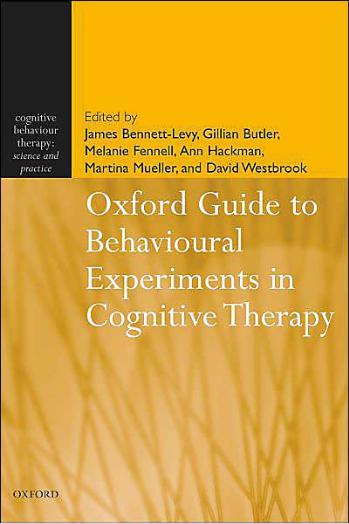
- •Contents
- •How to use this book
- •1. Behavioural experiments: historical and conceptual underpinnings
- •2. Devising effective behavioural experiments
- •3. Panic disorder and agoraphobia
- •4. Health anxiety
- •5. Obsessive-compulsive disorder
- •6. Generalized anxiety disorder
- •7. Social anxiety
- •8. Specific phobias
- •9. Post-traumatic stress disorder
- •10. Depression
- •11. Bipolar affective disorders
- •12. Psychotic symptoms
- •13. Eating disorders
- •14. Insomnia
- •15. Physical illness and disability
- •16. Acquired brain injury
- •17. Avoidance of affect
- •18. Self-injurious behaviour
- •19. Interpersonal difficulties
- •20. Low self-esteem
- •21. Behavioural experiments: at the crossroads
- •References
- •Index


Oxford Medical Publications
Oxford Guide to Behavioural Experiments in Cognitive Therapy

Cognitive behaviour therapy: science and practice series
Edited by
David Clark, Institute of Psychiatry, London, UK
Christopher Fairburn, University of Oxford, UK
Steven Hollon, Vanderbilt University, Nashville, USA
Other titles in the series:
The Treatment of Obsessions
S. Rachman

Oxford Guide to Behavioural Experiments in Cognitive Therapy
Edited by
James Bennett–Levy
Oxford Cognitive Therapy Centre, Warneford Hospital, Oxford, UK
Gillian Butler
Oxford Cognitive Therapy Centre and Department of Clinical Psychology,
Warneford Hospital, Oxford, UK
Melanie Fennell
Oxford Cognitive Therapy Centre and University of Oxford Department of Psychiatry, Warneford Hospital, Oxford, UK
Ann Hackmann
Oxford Cognitive Therapy Centre and University of Oxford Department of Psychiatry, Warneford Hospital, Oxford, UK
Martina Mueller
Oxford Cognitive Therapy Centre and Department of Clinical Psychology,
Warneford Hospital, Oxford, UK
David Westbrook
Oxford Cognitive Therapy Centre and Department of Clinical Psychology,
Warneford Hospital, Oxford, UK
Illustrations by
Khadj Rouf

Great Clarendon Street, Oxford OX2 6DP
Oxford University Press is a department of the University of Oxford.
It furthers the University’s objective of excellence in research, scholarship, and education by publishing worldwide in
Oxford New York
Auckland Bangkok Buenos Aires Cape Town Chennai
Dar es Salaam Delhi Hong Kong Istanbul Karachi Kolkata
Kuala Lumpur Madrid Melbourne Mexico City Mumbai Nairobi São Paulo Shanghai Taipei Tokyo Toronto
Oxford is a registered trade mark of Oxford University Press in the UK and in certain other countries
Published in the United States
by Oxford University Press Inc., New York
© Oxford University Press 2004
The moral rights of the author have been asserted Database right Oxford University Press (maker)
First published 2004
All rights reserved. No part of this publication may be reproduced, stored in a retrieval system, or transmitted, in any form or by any means, without the prior permission in writing of Oxford University Press,
or as expressly permitted by law, or under terms agreed with the appropriate reprographics rights organization. Enquiries concerning reproduction outside the scope of the above should be sent to the Rights Department, Oxford University Press, at the address above
You must not circulate this book in any other binding or cover and you must impose this same condition on any acquirer
A catalogue record for this title is available from the British Library
ISBN 0 19 8529155 (Hbk)
ISBN 0 19 8529163 (Pbk)
10 9 8 7 6 5 4 3 2 1
Typeset by Integra Software Services Pvt. Ltd, Pondicherry, India Printed in Great Britain
on acid-free paper by Biddles Ltd, King’s Lynn

Dedication
This book is dedicated to Joan Kirk, founder of the Oxford Cognitive Therapy
Centre and previously head of the Oxford NHS adult psychology service, with thanks for the energy, support, wisdom, and warmth without which many of us would have had neither the skills nor the nerve to produce this book.

Acknowledgements
First, and most importantly, we would like to acknowledge those who carried out the experiments and contributed to their design—our patients. This book would not exist without their courage, perseverance, and creativity. Second, we wish to acknowledge colleagues, supervisors, and supervisees, too numerous to name, who have contributed to the thinking of all those involved in this enterprise. Third, we thank our families and friends for their tolerance of the long hours and absences that have inevitably been part of the creation of this book. Fourth, a thank you to those who have generously contributed their stories for Tales from the Front Line: David Clark, Helen Close, Ann Gledhill, Lorna Hogg, Claudia Koch, Ali Modaresi, Fiona Kennedy, and Helen Rooney (other Tales were contributed by the editors). And lastly, we have been greatly supported by the unfailingly positive and flexible approach of our editor at Oxford University Press, Martin Baum; and the willingness of production editor Kate Smith to adopt late changes with grace and humour.

Foreword
David M. Clark
Oh, do not ask, “What is it?” Let us go and make our visit
From ‘Love Song of J. Alfred Prufrock’ (T.S. Eliot 1917)
Cognitive therapy aims to alleviate emotional distress by helping patients to identify and modify distorted patterns of thinking. Beck (1976) likens the enterprise to that of a scientific investigation. Patient and therapist are encouraged to view the patient’s beliefs as hypotheses to be evaluated in terms of the extent to which they are consistent with available data about the patient and his or her world. In session, discussions of the evidence for and against a particular belief are common. However, in his first comprehensive treatment manual (Beck et al. 1979, p. 56), Beck also pointed out that ‘a powerful method with which to investigate the validity of a specific assumption consists of designing an experiment or task to test the assumption empirically’. He went on to discuss how such an experiment could be developed. Patient and therapist first ‘specify . . . the assumption they want to test’. A task is then identified that allows an experimental test of the assumption. In particular, the task is set up in such a way that it can be agreed that if the assumption is correct, X will happen, whereas if the assumption is incorrect, some other outcome will occur. Once the experiment has been completed, ‘therapist and patient . . . evaluate the results of the experiment . . . consider various interpretations . . . and compare the actual results with the patient’s predictions based on the original assumption’.
Beck’s early enthusiasm for experiments was well justified. In the 25 years since the publication of Beck et al.’s seminal volume, effective cognitive therapy programmes have been developed for a wide range of disorders (see Hollon and Beck 2003; Nathan and Gorman 2002 for reviews). In most of the programmes ‘behavioural experiments’ in which patients are encouraged to test their beliefs through action are common. Detailed therapist manuals for many of the disorder-specific programmes are now available. However, currently there is no text that covers multiple disorders and specifically focuses on behavioural experiments. This volume admirably fills the gap.
A number of the empirically validated cognitive therapy programmes that have appeared in the last 25 years, especially those in anxiety disorders and eating disorders, have been developed by researchers working at the Warneford Hospital in Oxford. The distinguished authors of this volume, many of whom contributed

viii FOREWORD
to the development of the programmes, are, therefore, particularly well-placed to produce a definitive text. The reader will find here an impressive compendium of commonly used behavioural experiments, along with practical guidance in how to set up the experiments and how to discuss the results with patients. As the authors point out (see Chapters 1 and 2), behavioural experiments are not a therapy in themselves. Instead, they are tools to be used in the context of a comprehensive cognitive therapy programme. Such a programme would involve a close working relationship between patient and therapist in which collaborative empiricism and guided discovery are key principles. As Beck et al. (1979) clearly stated, a behavioural experiment can only be developed after patient and therapist have identified a particular assumption/belief/process to be investigated. In addition, the experiment is only likely to produce substantial cognitive change if the outcomes that would support different hypotheses are clearly operationalized, the results of the experiment are carefully reviewed, and the extent to which the results proved persuasive, or not, is openly discussed. Patients’ doubts about the persuasiveness of particular experiments should be elicited, listened to, and used to develop more fine tuned, and hopefully more persuasive, experiments.
A personal account
Behavioural experiments have played a major role in the cognitive therapy programmes that my colleagues* and I have developed for different anxiety disorders. The Editors of this volume kindly, but perhaps too generously, thought a brief historical account of some of the highlights of the programmes in terms of behavioural experiments might be of general interest.
Whilst a trainee clinical psychologist in the late 1970s, I came across a mimeographed copy of the manual that would eventually become Beck et al.’s (1979) classic text. I had my first chance to develop a behavioural experiment when presented with a phobic patient who seemed to obtain very little benefit from a carefully planned exposure therapy programme. Whilst observing the patient’s remarkable failure to show habituation during long periods of exposure, I noticed that she had episodes of markedly increased anxiety (panic attacks) during which she breathed quickly and deeply. A medical colleague indicated that the distinctive pattern of breathing constituted hyperventilation and expressed the view that this would generate anxiety by reducing the body’s CO2 level and instigating other biochemical changes. Keen to experience the process for myself, I vigorously hyperventilated and was surprised to discover that although I experi-
*Members of the research group who have been particularly influential in developing behavioural experiments include: Anke Ehlers, Melanie Fennell, Freda McManus, Ann Hackmann, Paul Salkovskis, and Adrian Wells.

FOREWORD ix
enced many body sensations, I did not feel particularly anxious. This observation led to an early, and restricted, version of what was later to be termed the cognitive theory of panic disorder (Clark 1986). In particular, I hypothesized that the patient’s anxiety attacks might be caused by interpreting the sensations induced by hyperventilation in a catastrophic fashion. This led to using induced hyperventilation as a way of demonstrating to patients that panic attacks have an innocuous cause. At the time, we often followed the induced hyperventilation behavioural experiment with some simple training in slow, shallow breathing.
Although many panic patients benefited from this combined approach, we noticed that some patients continued to be highly fearful of anxiety-related sensations and seemed driven to control the sensations. This observation, and some perceptive questioning by Martin Seligman (see Seligman 1988), led Paul Salkovskis to hypothesize that controlled breathing was acting as a safety-seeking behaviour that prevented cognitive change in some patients. Salkovskis’ (1988, 1991) perceptive analysis proved remarkably fruitful as it transpired that most panic disorder patients engaged in a wide range of in-situation safety behaviours. An effective behavioural experiment followed from the analysis. Patients were encouraged to induce feared sensations and then drop their attempts to control the symptoms as a highly effective way of learning that the sensations were harmless.
A key feature of the cognitive therapy for panic programme (see Clark 1996 for a description) was that it was not simply a set of techniques for discounting specific negative thoughts. Instead, patients were invited to compare two different ways of explaining their problem: on the one hand, the idea that the symptoms they experience are highly dangerous and a sign of a serious physical or mental problem (such as an impending heart attack or insanity); on the other hand, the idea that the problem is their erroneous belief that the symptoms are dangerous and the vicious circle of thoughts, feelings, and sensations that result from this belief.
Developing evidence for an alternative model or way of understanding a problem became even more important when we shifted our attention to hypochondriasis. Like panic disorder, hypochondriasis is characterized by misinterpretation of symptoms. However, the time course of the feared outcomes is typically longer. For example, a panic patient might interpret cardiac symptoms as a sign of a heart attack and imminent death, whereas a patient with hypochondriasis is more likely to interpret the symptoms as a sign of cardiovascular disease that will lead to physical handicap or death in months or years. Clearly, it is impossible to disconfirm the idea that someone may die in months or years in a treatment lasting weeks. In such a case, demonstrating the validity of the alternative, non-disease model is the key aim and the target of most behavioural experiments. For example, a patient who is concerned that he is developing throat cancer may frequently check that his throat is

xFOREWORD
functioning properly by intentionally swallowing. Such checking would produce discomfort and subjective difficulty in swallowing that would be seen by the patient as evidence of throat cancer. Belief in the alternative model, that the problem is his illness belief and the checking that follows from it, could be substantially strengthened by a behavioural experiment in which the patient intentionally swallows several times and observes the effects.
Social phobia has proved a particularly fertile ground for behavioural experiments. Clark and Wells (1995) proposed that the persistence of the disorder could be understood in terms of a faulty processing style in which attention is turned inwards and internal information (anxious feelings, negative images of oneself, and certain types of felt sense) is used to draw excessively negative inferences about how one appears to others. In addition, some safety behaviours contaminate the social interaction by having adverse effects on other people. Each of these points can be elegantly demonstrated by experiments in which focus of attention, safety behaviours, and/or self-imagery are manipulated. With respect to self-imagery, video feedback has proved a particularly powerful way of helping patients see that their view of how they appear to others is excessively negative.
In post-traumatic stress disorder (PTSD), behavioural experiments have proved similarly flexible and powerful. Faulty beliefs such as ‘If I allow myself to become anxious when I think about the trauma, I will be unable to cope/will go mad’ can be systematically tested. The problematic effects of safety behaviours (for example, attempts to suppress intrusions may increase the frequency of the intrusions) can be convincingly demonstrated. In addition, the potent mixture of inquisitiveness, hypothesis construction, and hypothesis testing that lies at the heart of behavioural experimentation can be used to understand and eventually eliminate highly puzzling symptoms. For example, it is common for patients with PTSD to report moments when they suddenly feel anxious for no apparent reason. Ehlers and Clark (2000) suggest that such episodes often represent activation of a fragment of the trauma memory (the terror) without source identification. Physical stimuli that resemble stimuli that were present at the time of the trauma often seem to trigger such activations. For example, the terror that was experienced in a road traffic accident at night might be triggered by a patch of sunlight on a lawn which resembles a headlight. Once this possible explanation has been advanced, the first experiment involves asking patients to look out for such stimuli in future episodes. If they are identified, the next experiment involves breaking the link between the stimuli and the trauma memory by intentionally using the stimuli to elicit the trauma memory and then focusing on the difference between the trauma and now (for example, ‘I thought I would die, but I didn’t. The event is in the past and I’m completely safe’). In this way the trauma memory is contextualized and re-experiencing is inhibited (see Ehlers and Clark 2000 for further details).

FOREWORD xi
An invitation
Enough of ‘What is it?’. You are now invited to turn the page to the rest of the book where the authors have skilfully laid out the world of behavioural experiments. In the immortal words of T.S. Eliot, ‘Let us go and make our visit’.
This page intentionally left blank

Preface
This is a book written by clinicians for clinicians. It is intended as a practical, easy-to-read guide, which is relevant for practising clinicians at every level from trainee to cognitive therapy supervisor. Its purpose is to provide a source of ideas which will stimulate the creativity of clinicians wishing to design behavioural experiments tailored to the individual cognitions of their patients.
We have written this book because it is a book that all the contributors wanted on their bookshelves. Despite the fact that behavioural experiments are amongst the most central, and the most powerful, interventions in cognitive therapy, there is a dearth of relevant literature which provides a practical, how-to-do-it focus for their design and implementation. Trainees often ask supervisors for ideas about designing and implementing behavioural experiments for particular patients. Experienced clinicians also may need access to practical ideas when working with their own patients or supervising trainees. In this volume, we have gathered over 200 examples of behavioural experiments across a range of different problems, to fill these gaps.
The fact that this book has emerged from Oxford is no accident, and may be attributed to several factors. In the early 1970s, a Psychological Treatment Research Unit was established in Oxford. This produced a stream of clinically relevant research that refined and tested the principles of behavioural practice. As the cognitive revolution gathered momentum, cognitive methods were gradually intertwined with behavioural ones, until the cognitive perspective assumed predominance. Throughout the remainder of the century, numerous clinicians working in Oxford participated in research projects, applied their ideas to increasingly complex problems, and made their findings widely accessible. Two threads running through more than a quarter of a century of research—rigorous thinking, and its subsequent application in the clinic— have directly influenced their thinking and their work.
During much of this time, two of the British researchers most responsible for the theoretical and practical development of behavioural experiments, David Clark and Paul Salkovskis, were based in Oxford. Salkovskis’ concept of safety-seeking behaviours has been particularly important in the development of behavioural experiments. Both Clark and Salkovskis have been highly influential in the development of effective cognitive behavioural treatments for the anxiety disorders and, together with their teams (including some of the present authors), have strongly emphasized the value of behavioural experiments. Clark’s ‘Foreword’ to this book outlines these developments.

xiv PREFACE
Oxford cognitive therapists have also had a particular interest in disseminating cognitive therapy widely, to patients and health professionals. Joan Kirk, one of the present authors, played an important role as head of the local National Health Service adult psychology department, building it up from three people to a far larger department with particular expertise in cognitive therapy. Members of that department have written booklets for patients and therapists and books that have made cognitive therapy methods accessible to the general public; many of them have also contributed to this book.
The diploma training course, ‘Cognitive Therapy in Oxford’, has been another major influence. This was one of the first specialist cognitive therapy courses in the UK and many of the present authors are teachers and supervisors on the course and/or have been participants. More recently, the Oxford Cognitive Therapy Centre has provided introductory and more specialist courses in cognitive therapy, as well as access to expert supervision, consultation, and therapy.
Hence, we have been able to gather in Oxford a critical mass of people with particular expertise in cognitive therapy, whose orientation places particular emphasis on testing out cognitions in the real world (i.e. behavioural experiments). This has been an important element in the development of this book.
The Oxford Guide has been very much a group project. When we started the book, we found that there was still a surprising amount of conceptual development which needed to be done. This has involved a creative oscillation between the first two chapters and the chapters on specific problems; and between the editors and the authors. In this sense, the Oxford Guide perhaps extends beyond a ‘normal’ edited book: the authors are more than simply chapter authors, and the editors more than simply editors.
We anticipate further conceptual and practical developments. The Oxford Guide to Behavioural Experiments in Cognitive Therapy represents a step along this path. Christine Padesky’s chapter points the way to future directions. One of our predictions is that there will be more chapters in future editions on transdiagnostic issues (e.g. perfectionism, procrastination) and in the area of health psychology.
Finally, it is our hope that the reader will gain as much from reading the book as we have in writing and editing it. For all of us, it has been a fascinating journey. It has significantly affected the way we think about the process of therapy and the clinical work that we do with patients. We hope that it will inspire novel, creative work on the part of cognitive therapy practitioners, as well as further research which investigates the particularly powerful influence of behavioural experiments in achieving therapeutic change.
The Editors
September 2003

Contents
List of contributors |
xvii |
How to use this book |
xix |
1.Behavioural experiments: historical and conceptual underpinnings 1
James Bennett–Levy, David Westbrook, Melanie Fennell, Myra Cooper, Khadj Rouf, and Ann Hackmann
2. Devising effective behavioural experiments 21
Khadj Rouf, Melanie Fennell, David Westbrook, Myra Cooper, and James Bennett–Levy
3. Panic disorder and agoraphobia 59
Ann Hackmann
4.Health anxiety 81
Amy Silver, Diana Sanders, Norma Morrison, and Carolyn Cowey
5.Obsessive-compulsive disorder 101
Norma Morrison and David Westbrook
6. Generalized anxiety disorder 121
Gillian Butler and Khadj Rouf
7.Social anxiety 141
Gillian Butler and Ann Hackmann
8.Specific phobias 161
Joan Kirk and Khadj Rouf
9. Post-traumatic stress disorder 183
Martina Mueller, Ann Hackmann, and Alison Croft
10.Depression 205
Melanie Fennell, James Bennett–Levy, and David Westbrook
11. Bipolar affective disorders 225
June Dent, Helen Close, and Joanne Ryder
12.Psychotic symptoms 245
Helen Close and Stefan Schuller
13.Eating disorders 267
Myra Cooper, Linette Whitehead, and Nicky Boughton

xviCONTENTS
14.Insomnia 287
Melissa Ree and Allison Harvey
15. |
Physical illness and disability 309 |
|
Amy Silver, Christina Surawy, and Diana Sanders |
16. |
Acquired brain injury 331 |
|
Joanna McGrath and Nigel King |
17. |
Avoidance of affect 351 |
|
Gillian Butler and Christina Surawy |
18.Self-injurious behaviour 373
Helen Kennerley
19.Interpersonal difficulties 393
Paul Flecknoe and Diana Sanders
20.Low self-esteem 413
Melanie Fennell and Helen Jenkins
21. Behavioural experiments: at the crossroads 433
Christine Padesky
References 439
Index 453

Contributors
James Bennett–Levy
Oxford Cognitive Therapy Centre,
Warneford Hospital, Oxford, UK
Nicky Boughton
Oxford Adult Eating Disorders
Service, Warneford Hospital,
Oxford, UK
Gillian Butler
Oxford Cognitive Therapy Centre and
Department of Clinical Psychology,
Warneford Hospital, Oxford, UK
Helen Close
Department of Clinical Psychology,
Warneford Hospital, Oxford, UK
Myra Cooper
Doctoral Course in Clinical
Psychology, University of Oxford,
Warneford Hospital, Oxford, UK
Carolyn Cowey
Department of Clinical Psychology,
Warneford Hospital, Oxford, UK
Alison Croft
Department of Clinical Psychology,
Warneford Hospital, Oxford, UK
June Dent
Department of Clinical Psychology,
Warneford Hospital, Oxford, UK
Melanie Fennell
Oxford Cognitive Therapy Centre
and University of Oxford Department
of Psychiatry, Warneford Hospital,
Oxford, UK
Paul Flecknoe
Clinical Psychology Services,
St Mary’s Hospital, Kettering, UK
Ann Hackmann
Oxford Cognitive Therapy Centre
and University of Oxford Department
of Psychiatry, Warneford Hospital,
Oxford, UK
Allison Harvey
Department of Experimental
Psychology, University of
Oxford, UK
Helen Jenkins
Department of Clinical Psychology,
Warneford Hospital, Oxford, UK
Helen Kennerley
Oxford Cognitive Therapy Centre,
Warneford Hospital, Oxford, UK
Nigel King
Doctoral Course in Clinical
Psychology, University of Oxford,
Warneford Hospital, Oxford, UK
Joan Kirk
Oxford Cognitive Therapy Centre,
Warneford Hospital, Oxford, UK
Joanna McGrath
Oxford Centre for Enablement, Oxford, UK
Norma Morrison
Oxford Cognitive Therapy Centre,
Warneford Hospital, Oxford, UK

xviii CONTRIBUTORS
Martina Mueller
Oxford Cognitive Therapy Centre and
Department of Clinical Psychology,
Warneford Hospital, Oxford, UK
Christine Padesky
Center for Cognitive Therapy, Huntington Beach CA, USA
Melissa Ree
Department of Psychiatry,
Warneford Hospital, Oxford, UK
Khadj Rouf
Department of Clinical Psychology,
Warneford Hospital, Oxford, UK
Joanne Ryder
Department of Clinical Psychology,
Warneford Hospital, Oxford, UK
Diana Sanders
Oxford Cognitive Therapy Centre,
Warneford Hospital, Oxford, UK
Stefan Schuller
Doctoral Course in Clinical
Psychology, University of Oxford,
Warneford Hospital, Oxford, UK
Amy Silver
Doctoral Course in Clinical
Psychology, University of Oxford,
Warneford Hospital, Oxford, UK
Christina Surawy
Department of Psychological
Medicine, John Radcliffe Hospital,
Oxford, UK
David Westbrook
Oxford Cognitive Therapy Centre and
Department of Clinical Psychology,
Warneford Hospital, Oxford, UK
Linette Whitehead
Oxford Adult Eating Disorders Service,
Warneford Hospital, Oxford, UK
